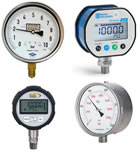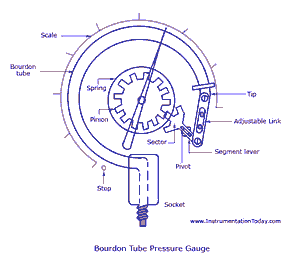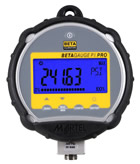Pros&Cons Digital Pressure Gauges
Advantages and disadvantages of digital pressure gauge
Briefly about barometers
Simply put, a barometer is a tool that provides the simplest, most direct way to measure and display gas and  liquid pressure . Barometers are common equipment in refineries and power plants and industrial plants that have a wide range of applications in various applications from health care to energy production and many other industries around the world.
liquid pressure . Barometers are common equipment in refineries and power plants and industrial plants that have a wide range of applications in various applications from health care to energy production and many other industries around the world.
Analog meters were first developed more than 150 years ago and became popular in factory steam processes during the Industrial Revolution. It is difficult to understand that despite the rapidly changing world of the world today, the basic mechanical mechanism in analog barometers has hardly changed until around the 1970s and 1980s. At the same time, it was the beginning of the digital age that led to the development of the first digital Pressure gauge.
Since the 2000s, with the introduction of new production techniques and technologies, and more sophisticated construction materials available, significant advances have been made in both. And although it can be assumed that analog measurements will exist for a long time, digital barometers now have many advantages over traditional analog meters. In this article, we look at the fundamental differences between the two and the myriad advantages of digital over analog pressure gauges.
Advantages and disadvantages of digital and analog Pressure gauges
Although analog and digital Pressure gauges both perform the same functions of pressure measurement and use very different technologies, each has its own application. In practice, digital Pressure gauges are superior in various applications. There are several distinct features of digital Pressure gauges that actually make their use superior to the standard analog gauge of the industrial age.
Analog barometer


Advantages : Measuring with a barometer or analog gauge is inexpensive and easy to use, and because they are made of mechanical parts, they do not require an energy source or power supply.
Disadvantages : Analog pressure gauges or pressure gauges are completely mechanical. They are made of small gears and moving parts, so they are more likely to be damaged over time under normal conditions in an industry or laboratory. As a result, analog Pressure gauges, especially those that are subject to mechanical vibration and in applications with a constant pressure pulse, the moving parts of analog Pressure gauges can be quickly destroyed, leading to misreadings and potentially unsafe working conditions. Analog pressure gauges are prone to failure in overpressure, extreme temperatures, corrosion, clogging, vibration and steam, so they need constant and constant calibration. At the same time, the analog pressure gauge calibration requires the opening and manipulation of adjusting screws, which can again be damaged by user error.
Digital Pressure gauges
Digital Pressure gauges use pressure transducers to display and read pressure on a digital indicator  . They provide fast, clear, and legible results based on settings that the user enters before the measurement. Digital Pressure gauges are reliable and provide continuous readings and are usually powered by batteries in the form of loop power or two wires or solar energy.
. They provide fast, clear, and legible results based on settings that the user enters before the measurement. Digital Pressure gauges are reliable and provide continuous readings and are usually powered by batteries in the form of loop power or two wires or solar energy.
Advantages : There are several main features of digital Pressure gauges compared to their analog counterparts below.
Durability - Digital Pressure gauges are able to function with less failure in extreme temperatures, hazardous conditions and areas that are subject to heavy mechanical vibration. In order to withstand corrosion, they are typically made of aluminum or stainless steel with thick, corrosion-resistant plastic covers to protect them from shock, moisture, particulate matter, and hazardous chemicals. As a result, they are much more resistant to analog sensors and more resistant to vibration and overpressure than to pressure peaks.
Calibration - A calibrated digital Pressure gauge remains much more reliable than a calibrated Pressure gauge with analog output. Digital calibration is done using software, so it is much more accurate.
Customization option- Digital Pressure gauges can be adjusted to fit your application - You can add and remove features and modify engineering units or scale. Some digital Pressure gauges have the ability to create custom units that allow the pressure to be displayed in torque or force units or when needed in a custom application. In practice with analog devices it is almost impossible - to change the units you have to change the whole dial. Many digital gauges also automatically record maximum and minimum values, so this important information can be noted quickly - usually at the touch of a button. Analog Pressure gauges require tracking markers to do this, which is a bit troublesome to adjust and inaccurate. And a big advantage of digital in data collection.
Readability - Digital Pressure gauges have a clear, readable screen for reading compressed values. Most of them also include bright backlight. Reading an analog barometer always requires interpreting the location of the hand. In some applications, where there is a need to read from a distance, or to measure several pressure readings at once, the analog Pressure gauge is often preferred due to its fast nature and a glance at the screen. But analog barometers are often misread in places where the reading seems to be different based on the angle of the person interpreting the data and in different situations due to parallax error.
Disadvantages : Keep in mind that a digital Pressure gauge always requires a power supply or battery, so if your use of the Pressure gauge is infrequent, it may not be an ideal choice. Batteries do not last forever, especially when left on the shelf for months. It is also important to recognize that digital Pressure gauges require special certifications that are mandatory in some industries (typically used in hazardous situations and explosive environments), and it is best to use other analog models that do not require certification.
There will be no discussion of comparing analog and digital pressure gauges in terms of cost. They are more expensive because digital devices use advanced microprocessors and equipment. However, analog Pressure gauges often break down - they are not reliable enough, and they need to be recalibrated and replaced, so what saves money may cost you in the long run. Brought more.
Which type of Pressure gauge is right for you?
Ultimately, choosing what type of Pressure gauge is recommended for you will always be tailored to your specific application needs. There will probably always be times in the industry to use an analog Pressure gauge, but if you rely on accurate pressure gauges to do your job, it is best to switch your Pressure gauge to a digital model.
